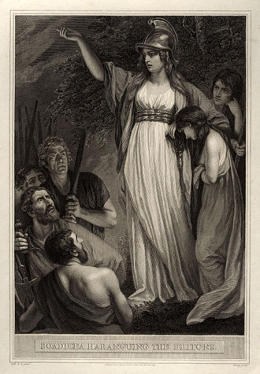

Website designed and maintained by Microport © 2010 -20

BOUDICA’S BROOCH (S6x32) 2C
Anthony C Payne (2019)
1- 8
1s+2s
dance
first
6
bars
of
Diamond
Poussette
&
on
7-8
turn
BH
to
line of 4 up/down centre-line (M above L)
9-24
1s+2s
dance
full
Celtic
Reel,
ending
in
same
positions
as
start
of
figure
25-28
1s+2s set to partner, Petronella turn to own sides
29-32
1s+2s Set&Link to change places
Boudica
or
Boudicca,
also
known
as
Boadicea
or
Boudicea,
and
in
Welsh
as
Buddug
was
a
queen
of
the
British
Celtic
Iceni
tribe
who
led
an
uprising
against
the
occupying
forces
of
the
Roman
Empire
in
AD
60
or
61.
She
died
shortly after its failure and is considered a British folk hero.
The
story
which
we
have
is
based
on
the
writings
of
Tacitus
(whose
father-in-law
was
a
military
tribune
under
Suetonius Paulinus at the time) with added embellishments, which cannot be verified, by Cassius Dio.
Boudica
was
of
royal
descent,
described
as
tall,
with
tawny
hair
hanging
down
to
below
her
waist,
a
harsh
voice
and
a
piercing
glare.
She
habitually
wore
a
large
golden
necklace
(perhaps
a
torc),
a
colourful
tunic,
and
a
thick
cloak
fastened
by
a
brooch.
Boudica's
husband,
Prasutagus,
was
the
king
of
the
Iceni,
a
people
who
inhabited
roughly what is now Norfolk.
The
immediate
cause
of
the
rebellion
was
gross
mistreatment
by
the
Romans.
Tacitus
wrote,
"
The
Icenian
king
Prasutagus,
celebrated
for
his
long
prosperity,
had
named
the
emperor
his
heir,
together
with
his
two
daughters;
an
act
of
deference
which
he
thought
would
place
his
kingdom
and
household
beyond
the
risk
of
injury.
The
result
was
contrary
–
so
much
so
that
his
kingdom
was
pillaged
by
centurions,
his
household
by
slaves;
as
though
they
had
been
prizes
of
war.
"
He
added
that
Boudica
was
lashed,
her
two
daughters
were
raped, and that the estates of the leading Iceni men were confiscated.
In
AD
60
or
61,
while
the
current
governor,
Gaius
Suetonius
Paulinus,
was
leading
a
campaign
against
the
island
of
Mona
(modern
Anglesey)
in
the
north
of
Wales,
which
was
a
refuge
for
British
rebels
and
a
stronghold
of
the
druids,
the
Iceni
conspired
with
their
neighbours
the
Trinovantes,
amongst
others,
to
revolt.
Boudica
was
chosen
as
their
leader.
Tacitus
records
that
she
addressed
her
army
with
these
words,
"It
is
not
as
a
woman
descended
from
noble
ancestry,
but
as
one
of
the
people
that
I
am
avenging
lost
freedom,
my
scourged
body,
the
outraged
chastity
of
my
daughters,"
and
concluded,
"This
is
a woman's resolve; as for men, they may live and be slaves."
The
rebels'
first
target
was
Camulodunum
(modern
Colchester),
the
former
Trinovantian
capital
and,
at
that
time,
a
Roman
colonia.
Boudica's
army
fell
on
the
poorly
defended
city
and
destroyed
it,
besieging
the
last
defenders
in
the
temple
for
two
days
before
it
fell.
Archaeologists
have
shown
that
the
city
was
methodically
demolished.
The
future
governor
Quintus
Petillius
Cerialis,
then
commanding
the
Legio
IX
Hispana,
attempted
to
relieve
the
city,
but
suffered
an
overwhelming
defeat.
The
infantry
with
him
were
all
killed
–
only
the
commander and some of his cavalry escaped.
When
news
of
the
rebellion
reached
Suetonius,
he
hurried
along
Watling
Street
through
hostile
territory
towards
Londinium,
a
relatively
new
settlement,
founded
after
the
conquest
of
AD
43,
but
one
which
had
grown
into
a
thriving
commercial
centre
with
a
population
of
traders,
and,
probably,
Roman
officials.
Suetonius
considered
giving
battle
there,
but
considering
his
lack
of
numbers
and
mindful
of
the
fall
of
Camulodunum,
decided
to
sacrifice
the
city
to
save
the
province.
Londinium
was
therefore
abandoned
to
the
rebels,
who
burnt
it
down,
torturing
and
killing
anyone
who
had
not
evacuated.
Archaeology
shows
a
thick
red
layer
of
burnt
debris
covering
coins and pottery dating before AD 60 within the bounds of Roman Londinium.
Verulamium
(St
Albans)
was
next
to
be
destroyed.
In
the
three
settlements
destroyed,
between
seventy
and
eighty
thousand
people
are
said
to
have
been
killed.
Tacitus
says
that
the
Britons
had
no
interest
in
taking
or
selling prisoners, only in slaughter by gibbet, fire, or cross, and the accounts make gruesome reading.
While
Boudica's
army
continued
their
assault
in
Verulamium
(St.
Albans),
Suetonius
regrouped
his
forces
until
he
commanded
an
army
of
almost
ten
thousand
men
and
then
took
a
stand
at
an
unidentified
location,
probably
in
the
West
Midlands
somewhere
along
the
Roman
road
now
known
as
Watling
Street,
“
in
a
defile
with
a
wood
behind
him
”
–
but
his
men
were
heavily
outnumbered.
Dio
says
that,
even
if
they
were
lined
up
one
deep,
they
would
not
have
extended
the
length
of
Boudica's
line
which
by
now
were
said
to
have
numbered
230,000–300,000
(a
probable
over-estimate).
However,
the
Romans
won
a
decisive
victory
“
The
glory
won
in
the
course
of
the
day
was
remarkable,
and
equal
to
that
of
our
older
victories:
for,
by
some
accounts,
little
less
than
eighty
thousand
Britons fell, at a cost of some four hundred Romans killed and a not much greater number of wounded.
”
According
to
Tacitus,
Boudica
poisoned
herself,
though
Dio
says
she
fell
sick
and
died
and
then
was
given
a
lavish
burial. There is no record of what happened to her two daughters.
The
location
of
Boudica's
defeat
is
unknown.
Many
historians
favour
a
site
in
the
West
Midlands,
somewhere
along the Roman road now known as Watling Street:
•
A site close to High Cross, Leicestershire, on the junction of Watling Street and the Fosse Way
•
Manduessedum (Mancetter), near the modern town of Atherstone in Warwickshire
•
More
recently,
a
discovery
of
Roman
artefacts
in
Kings
Norton
close
to
Metchley
Camp
has
suggested
another
possibility
•
A
thorough
examination
of
a
stretch
of
Watling
Street
between
St.
Albans,
Boudica's
last
known
location,
and
the
Fosse
Way
junction
has
suggested
the
Cuttle
Mill
area
of
Paulerspury
in
Northamptonshire,
which
has
topography
very
closely
matching
that
described
by
Tacitus
of
the
scene
of
the
battle,
and
where
large
quantities
of
human
bones
of
both
sexes,
and
including
children,
have
been
found
over
a
wide
area
together
with fragments of Roman pottery from the 1
st
century
•
In
March
2010,
evidence
was
published
suggesting
the
site
may
be
located
at
Church
Stowe,
Northamptonshire
In
2009,
it
was
suggested
that
the
Iceni
were
returning
to
East
Anglia
along
the
Icknield
Way
when
they
encountered the Roman army in the vicinity of Arbury Banks, Hertfordshire.
[extracted from Wikipedia}

Boadicea Haranguing the Britons






